On-Chip Reconfigurable and Ultracompact Silicon Waveguide Mode Converters Based on Nonvolatile Optical Phase Change Materials
Abstract
:1. Introduction
2. Device Structure and Principle
2.1. The Device Structure Design and Materials
2.2. The Device Working Principle and Calculation Method
3. Results and Discussion
4. Conclusions
Author Contributions
Funding
Institutional Review Board Statement
Informed Consent Statement
Data Availability Statement
Conflicts of Interest
References
- Margalit, N.; Xiang, C.; Bowers, S.M.; Bjorlin, A.; Blum, R.; Bowers, J.E. Perspective on the future of silicon photonics and electronics. Appl. Phys. Lett. 2021, 118, 220501. [Google Scholar] [CrossRef]
- Siew, S.Y.; Li, B.; Gao, F.; Zheng, H.Y.; Zhang, W.; Guo, P.; Xie, S.W.; Song, A.; Dong, B.; Luo, L.W.; et al. Review of silicon photonics technology and platform development. J. Light. Technol. 2021, 39, 4374–4389. [Google Scholar] [CrossRef]
- Rickman, A. The commercialization of silicon photonics. Nat. Photonics 2014, 8, 579–582. [Google Scholar] [CrossRef]
- Thomson, D.; Zilkie, A.; Bowers, J.E.; Komljenovic, T.; Reed, G.T.; Vivien, L.; Marris-Morini, D.; Cassan, E.; Virot, L.; Fedeli, J.M.; et al. Roadmap on silicon photonics. J. Opt. 2016, 18, 073003. [Google Scholar] [CrossRef]
- Rahim, A.; Spuesens, T.; Baets, R.; Bogaerts, W. Open-access silicon photonics: Current status and emerging initiatives. Proc. IEEE 2018, 106, 2313–2330. [Google Scholar] [CrossRef] [Green Version]
- Dong, P. Silicon photonic integrated circuits for wavelength-division multiplexing applications. IEEE J. Sel. Top. Quantum Electron. 2016, 22, 6100609. [Google Scholar] [CrossRef]
- Luo, L.-W.; Ophir, N.; Chen, C.P.; Gabrielli, L.H.; Poitras, C.B.; Bergmen, K.; Lipson, M. WDM-compatible mode-division multiplexing on a silicon chip. Nat. Commun. 2014, 5, 3069. [Google Scholar] [CrossRef] [PubMed] [Green Version]
- Dai, D.; Li, C.; Wang, S.; Wu, H.; Shi, Y.; Wu, Z.; Gao, S.; Dai, T.; Yu, H.; Tsang, H.-K. 10-channel mode (de)multiplexer with dual polarizations. Laser Photonics Rev. 2018, 12, 1700109. [Google Scholar] [CrossRef]
- Tan, Y.; Wu, H.; Dai, D. Silicon-based hybrid (de)multiplexer for wavelength-/polarization-division-multiplexing. J. Light. Technol. 2018, 36, 2051–2058. [Google Scholar] [CrossRef]
- Han, X.; Xiao, H.; Liu, Z.; Zhao, T.; Jia, H.; Yang, J.; Eggleton, B.J.; Tian, Y. Reconfigurable on-chip mode exchange for mode-division multiplexing optical networks. J. Light. Technol. 2019, 37, 1008–1013. [Google Scholar] [CrossRef]
- Zhou, D.; Sun, C.; Lai, Y.; Yu, Y.; Zhang, X. Integrated silicon multifunctional mode-division multiplexing system. Opt. Express 2019, 27, 10798–10805. [Google Scholar] [CrossRef] [PubMed]
- Wu, X.; Huang, C.; Xu, K.; Shu, C.; Tsang, H.-K. Mode-division multiplexing for silicon photonic network-on-chip. J. Light. Technol. 2017, 35, 3223–3228. [Google Scholar] [CrossRef] [Green Version]
- Li, C.; Liu, D.; Dai, D. Multimode silicon photonics. Nanophotonics 2019, 8, 227–247. [Google Scholar] [CrossRef]
- Sun, C.; Ding, Y.; Li, Z.; Qi, W.; Yu, Y.; Zhang, X. Key multimode silicon photonic devices inspired by geometrical optics. ACS Photonics 2020, 7, 2037–2045. [Google Scholar] [CrossRef]
- Sun, C.; Yu, Y.; Chen, G.; Zhang, X. Integrated switchable mode exchange for reconfigurable mode-multiplexing optical networks. Opt. Lett. 2016, 41, 3257–3260. [Google Scholar] [CrossRef] [PubMed] [Green Version]
- Liu, L.; Ding, Y.; Yvind, K.; Hvam, J.M. Efficient and compact TE-TM polarization converter built on silicon-on-insulator platform with a simple fabrication process. Opt. Lett. 2011, 36, 1059–1061. [Google Scholar] [CrossRef]
- Hao, L.; Xiao, R.; Shi, Y.; Dai, P.; Zhao, Y.; Liu, S.; Lu, J.; Chen, X. Efficient TE-polarized mode-order converter based on high-index-contrast polygonal slot in a silicon-on-insulator waveguide. IEEE Photonics J. 2019, 11, 6601210. [Google Scholar] [CrossRef]
- Zhao, Y.; Guo, X.; Zhang, Y.; Xiang, J.; Wang, K.; Wang, H.; Su, Y. Ultra-compact silicon mode-order converters based on dielectric slots. Opt. Lett. 2020, 45, 3797–3800. [Google Scholar] [CrossRef]
- Xu, Y.; Zhu, C.; Hu, X.; Dong, Y.; Zhang, B.; Ni, Y. On-chip silicon shallowly etched TM0-to-TM1 mode-order converter with high conversion efficiency and low modal crosstalk. J. Opt. Soc. Am. B 2020, 37, 1290–1297. [Google Scholar] [CrossRef]
- Liu, L.; Xu, Y.; Wen, L.; Dong, Y.; Zhang, B.; Ni, Y. Design of a compact silicon-based TM-polarized mode-order converter based on shallowly etched structures. Appl. Opt. 2019, 58, 9075–9081. [Google Scholar] [CrossRef] [PubMed]
- Jia, H.; Chen, H.; Wang, T.; Xiao, H.; Ren, G.; Mitchell, A.; Yang, J.; Tian, Y. Multi-channel parallel silicon mode-order converter for multimode on-chip optical switching. IEEE J. Sel. Top. Quantum Electron. 2020, 26, 8302106. [Google Scholar] [CrossRef]
- Liu, D.; Tan, Y.; Khoram, E.; Yu, Z. Training deep networks for the inverse design of nanophotonic structures. ACS Photonics 2018, 5, 1365–1369. [Google Scholar] [CrossRef] [Green Version]
- Frellsen, L.F.; Ding, Y.; Sigmund, O.; Frandsen, L.H. Topology optimized mode multiplexing in silicon-on-insulator photonic wire waveguides. Opt. Express 2016, 24, 16866–16873. [Google Scholar] [CrossRef] [PubMed] [Green Version]
- Cheng, Z.; Wang, J.; Yang, Z.; Yin, H.; Wang, W.; Huang, Y.; Ren, X. Broadband and high extinction ratio mode converter using the tapered hybrid plasmonic waveguide. IEEE Photonics J. 2019, 11, 4900608. [Google Scholar] [CrossRef]
- Chen, R.; Bai, B.; Yang, F.; Zhou, Z. Ultra-compact hybrid plasmonic mode converter based on unidirectional eigenmode expansion. Opt. Lett. 2020, 45, 803–806. [Google Scholar] [CrossRef] [PubMed]
- Zhu, D.; Ye, H.; Yu, Z.; Li, J.; Yu, F.; Liu, Y. Design of compact TE-polarized mode-order converter in silicon waveguide with high refractive index material. IEEE Photonics J. 2018, 10, 6602907. [Google Scholar] [CrossRef]
- Wuttig, M.; Bhaskaran, H.; Taubner, T. Phase-change materials for non-volatile photonic applications. Nat. Photonics 2017, 11, 465–476. [Google Scholar] [CrossRef]
- Lian, C.; Vagionas, C.; Alexoudi, T.; Pleros, N.; Youngblood, N.; Rios, C. Photonic (computational) memories: Tunable nanophotonics for data storage and computing. Nanophotonics 2022, 11, 3823–3854. [Google Scholar] [CrossRef]
- Wu, C.; Yu, H.; Li, H.; Zhang, X.; Takeuchi, I.; Li, M. Low-loss integrated photonic switch using subwavelength patterned phase change material. ACS Photonics 2019, 6, 87–92. [Google Scholar] [CrossRef]
- Nisar, M.S.; Yang, X.; Lu, L.; Chen, J.; Zhou, L. On-chip integrated photonic devices based on phase change materials. Photonics 2021, 8, 205. [Google Scholar] [CrossRef]
- Brückerhoff-Plückelmann, F.; Feldmann, J.; Wright, C.D.; Bhaskaran, H.; Pernice, W.H.P. Chalcogenide phase-change devices for neuromorphic photonic computing. J. Appl. Phys. 2021, 129, 151103. [Google Scholar] [CrossRef]
- Feldmann, J.; Youngblood, N.; Wright, C.D.; Bhaskaran, H.; Pernice, W.H.P. All-optical spiking neurosynaptic networks with self-learning capabilities. Nature 2019, 569, 208–214. [Google Scholar] [CrossRef] [PubMed] [Green Version]
- Delaney, M.; Zeimpekis, I.; Lawson, D.; Hewak, D.W.; Muskens, O.L. A new family of ultralow loss reversible phase-change materials for photonic integrated circuits: Sb2S3 and Sb2Se3. Adv. Funct. Mat. 2020, 30, 2002447. [Google Scholar] [CrossRef]
- Delaney, M.; Zeimpekis, I.; Du, H.; Yan, X.; Banakar, M.; Thomson, D.J.; Hewak, D.W.; Muskens, O.L. Nonvolatile programmable silicon photonics using an ultralow-loss Sb2Se3 phase change material. Sci. Adv. 2021, 7, eabg3500. [Google Scholar] [CrossRef]
- Liu, W.; Li, M.; Guzzon, R.S.; Norberg, E.J.; Parker, J.S.; Lu, M.; Coldren, L.A.; Yao, J. A fully reconfigurable photonic integrated signal processor. Nat. Photonics 2016, 10, 190–195. [Google Scholar] [CrossRef]
- Bogaerts, W.; Pérez, D.; Capmany, J.; Miller, D.A.B.; Poon, J.; Englund, D.; Morichetti, F.; Melloni, A. Programmable photonic circuits. Nature 2020, 586, 207–216. [Google Scholar] [CrossRef] [PubMed]
- Xu, X.; Ren, G.; Feleppa, T.; Liu, X.; Boes, A.; Mitchell, A.; Lowery, A.J. Self-calibrating programmable photonic integrated circuits. Nat. Photonics 2022, 16, 595–602. [Google Scholar] [CrossRef]
- Fang, Z.; Chen, R.; Zheng, J.; Majumdar, A. Non-volatile reconfigurable silicon photonics based on phase-change materials. IEEE J. Sel. Top. Quantum Electron. 2022, 28, 8200317. [Google Scholar] [CrossRef]
- Parra, J.; Olivares, I.; Brimont, A.; Sanchis, P. Toward nonvolatile switching in silicon photonic devices. Laser Photonics Rev. 2021, 15, 2000501. [Google Scholar] [CrossRef]
- Jung, Y.; Han, H.; Sharma, A.; Jeong, J.; Parkin, S.S.P.; Poon, J.K.S. Integrated hybrid VO2-silicon optical memory. ACS Photonics 2022, 9, 217–223. [Google Scholar] [CrossRef]
- Wu, D.; Yang, X.; Wang, N.; Lu, L.; Chen, J.; Zhou, L.; Rahman, B.M.A. Resonant multilevel optical switching with phase change material GST. Nanophotonics 2022, 11, 3437–3446. [Google Scholar] [CrossRef]
- Miller, K.J.; Haglund, R.F.; Weiss, S.M. Optical phase change materials in integrated silicon photonics: Review. Opt. Mat. Express 2018, 8, 2415–2429. [Google Scholar] [CrossRef]
- Faneca, J.; Meyer, S.; Gardes, F.Y.; Chigrin, D.N. Graphene microheater for phase change chalcogenides based integrated photonic components. Opt. Mat. Express 2022, 12, 1991–2002. [Google Scholar] [CrossRef]
- Fang, Z.; Chen, R.; Zheng, J.; Khan, A.I.; Neilson, K.M.; Geiger, S.J.; Callahan, D.M.; Moebius, M.G.; Saxena, A.; Chen, M.E.; et al. Ultra-low-energy programmable non-volatile silicon photonics based on phase-change materials with graphene heaters. Nat. Nanotechnol. 2022, 17, 842–848. [Google Scholar] [CrossRef] [PubMed]
- Xu, Y.; Li, F.; Kang, Z.; Huang, D.; Zhang, X.; Tam, H.-Y.; Wai, P.K.A. Hybrid graphene-silicon based polarization-insensitive electro-absorption modulator with high-modulation efficiency and ultra-broad bandwidth. Nanomaterials 2019, 9, 157. [Google Scholar] [CrossRef] [PubMed] [Green Version]
- Shu, H.; Su, Z.; Huang, L.; Wu, Z.; Wang, X.; Zhang, Z.; Zhou, Z. Significantly high modulation efficiency of compact graphene modulator based on silicon waveguide. Sci. Rep. 2018, 8, 991. [Google Scholar] [CrossRef] [PubMed] [Green Version]
- Sullivan, D.M. Electromagnetic Simulation Using the FDTD Method; IEEE Press: Piscataway, NJ, USA, 2000. [Google Scholar]
- Lumerical FDTD Solutions. Available online: https://www.lumerical.com/products/fdtd/ (accessed on 12 August 2022).
- Stojanović, V.; Ram, R.J.; Popović, M.; Lin, S.; Moazeni, S.; Wade, M.; Sun, C.; Alloatti, L.; Atabaki, A.; Pavanello, F.; et al. Monolithic silicon-photonic platforms in state-of-the-art CMOS SOI processes. Opt. Express 2018, 26, 13106–13121. [Google Scholar] [CrossRef] [PubMed] [Green Version]
- Vieu, C.; Carcenac, F.; Pépin, A.; Chen, Y.; Mejias, M.; Lebib, A.; Manin-Ferlazzo, L.; Couraud, L.; Launois, H. Electron beam lithography: Resolution limits and applications. Appl. Surf. Sci. 2000, 164, 111–117. [Google Scholar] [CrossRef]
- Palik, E.D. Handbook of Optical Constants of Solids; American Academic Press: Salt Lake City, UT, USA, 1998. [Google Scholar]
- Gutiérrez, Y.; Ovvyan, A.P.; Santos, G.; Juan, D.; Rosales, S.A.; Junquera, J.; García-Fernández, P.; Dicorato, S.; Giangregorio, M.M.; Dilonardo, E.; et al. Interlaboratory study on Sb2S3 interplay between structure, dielectric function, and amorphous-to-crystalline phase change for photonics. iScience 2022, 25, 104377. [Google Scholar] [CrossRef] [PubMed]
- COMSOL Multiphysics. Available online: https://www.comsol.com/comsol-multiphysics/ (accessed on 5 September 2022).
- Xu, Y.; Liu, L.; Hu, X.; Dong, Y.; Zhang, B.; Ni, Y. Scalable silicon-based mode-order converters assisted by tapered metal strip layer. Opt. Laser Technol. 2022, 151, 108028. [Google Scholar] [CrossRef]
- He, Q.; Youngblood, N.; Cheng, Z.; Miao, X.; Bhaskaran, H. Dynamically tunable transmissive color filters using ultra-thin phase change materials. Opt. Express 2020, 28, 39841–39849. [Google Scholar] [CrossRef] [PubMed]

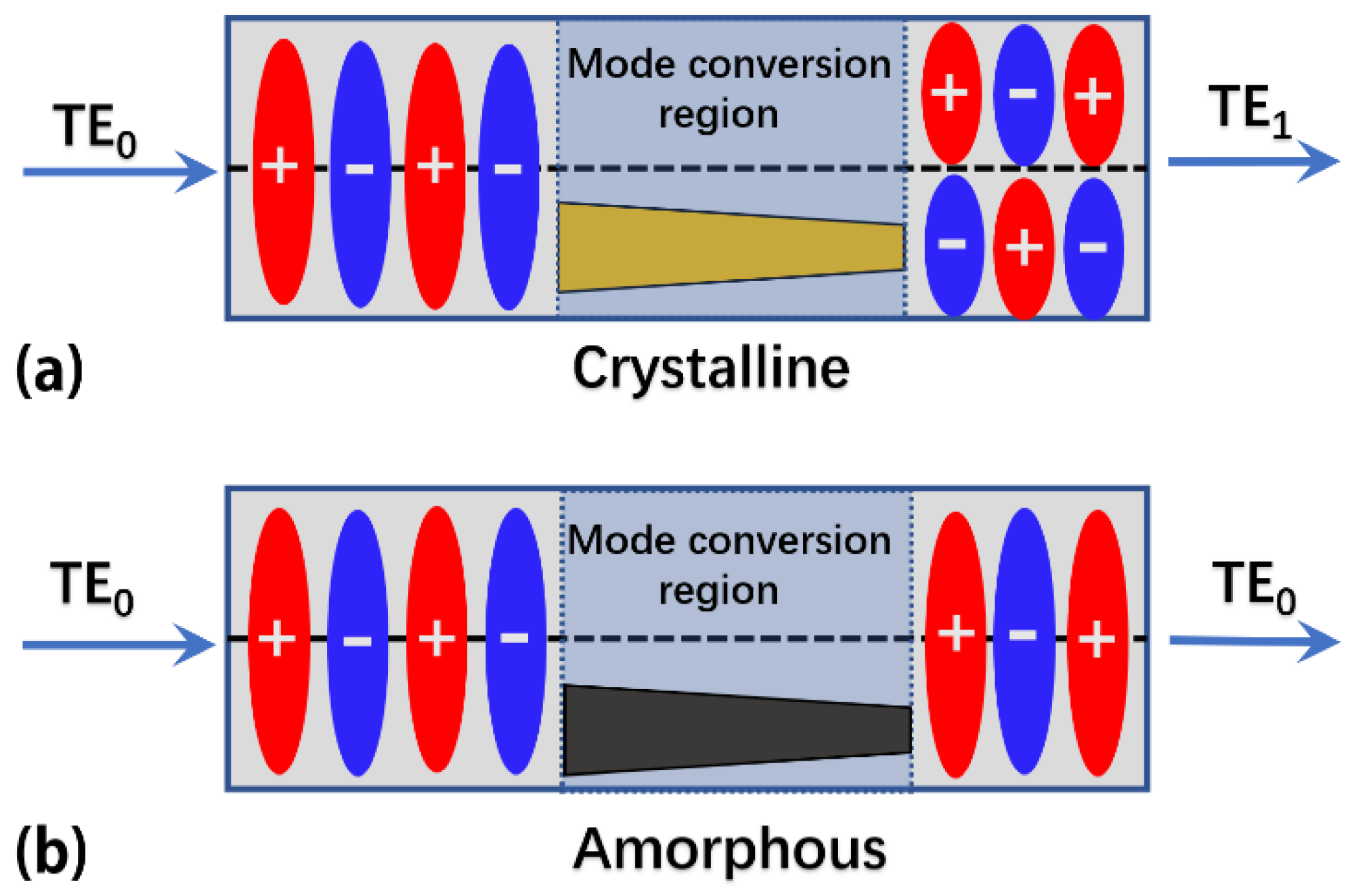
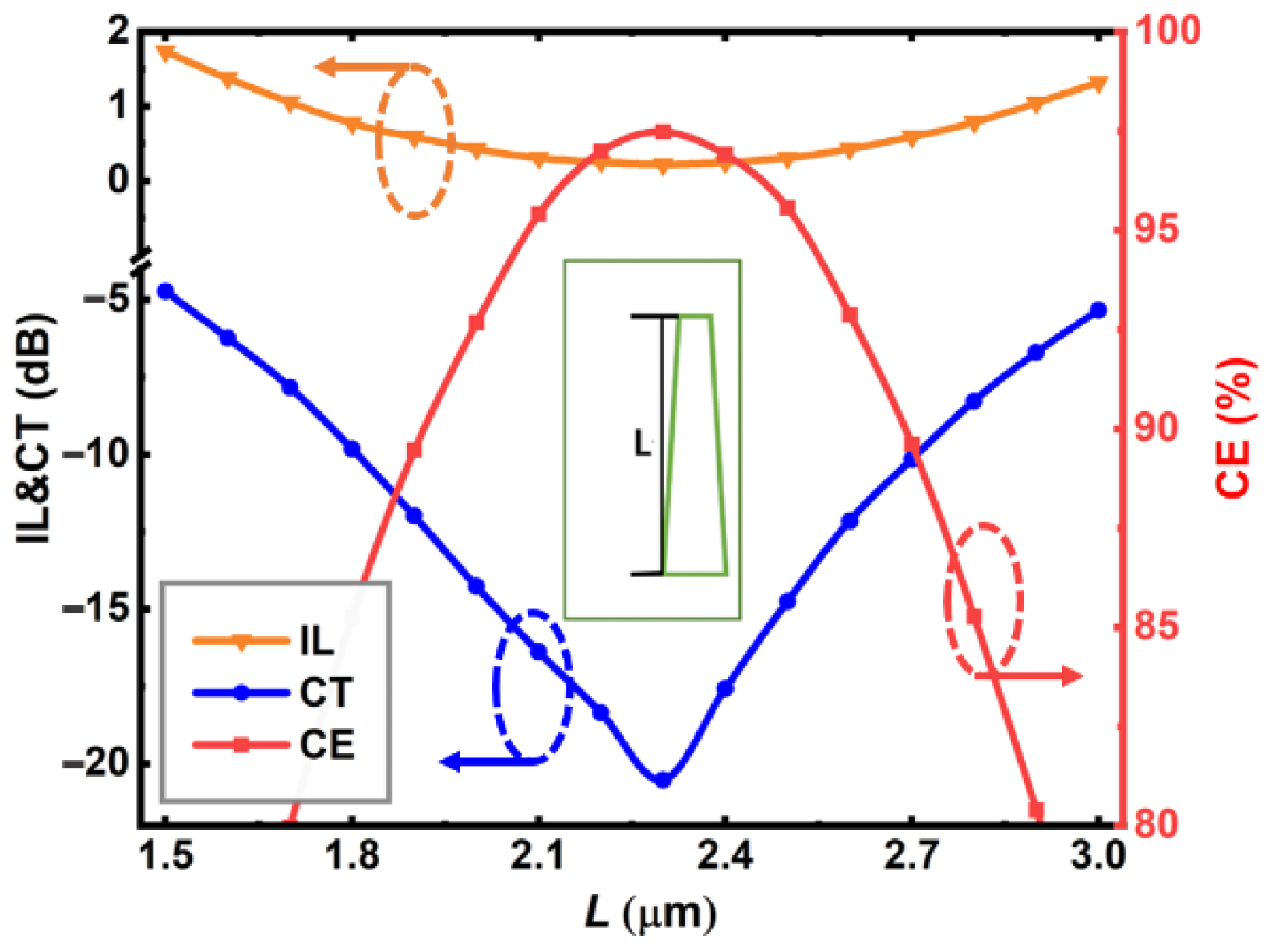
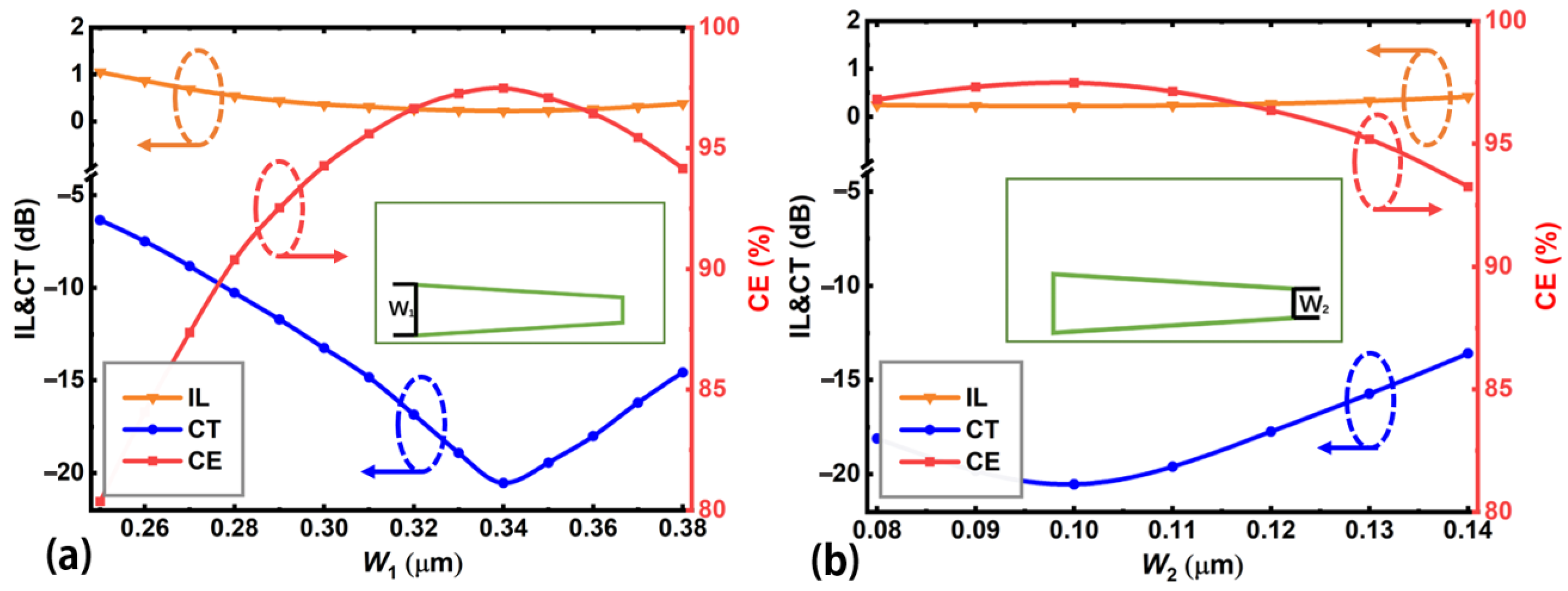
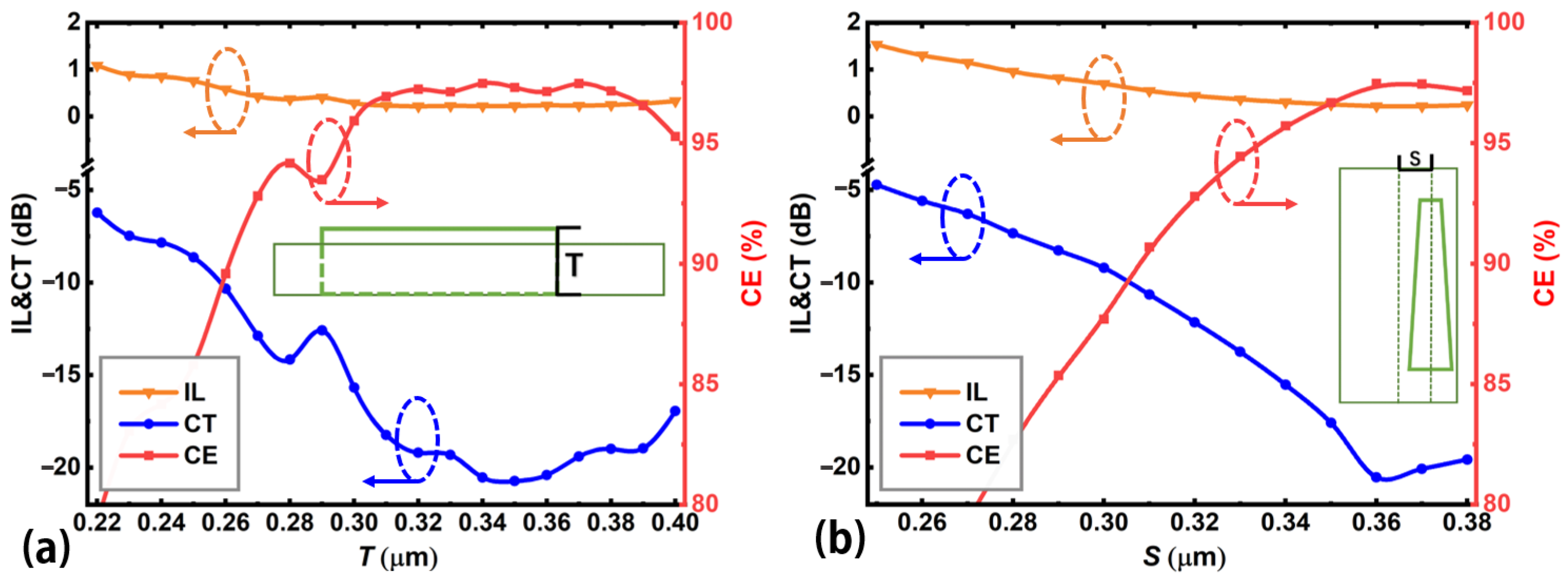

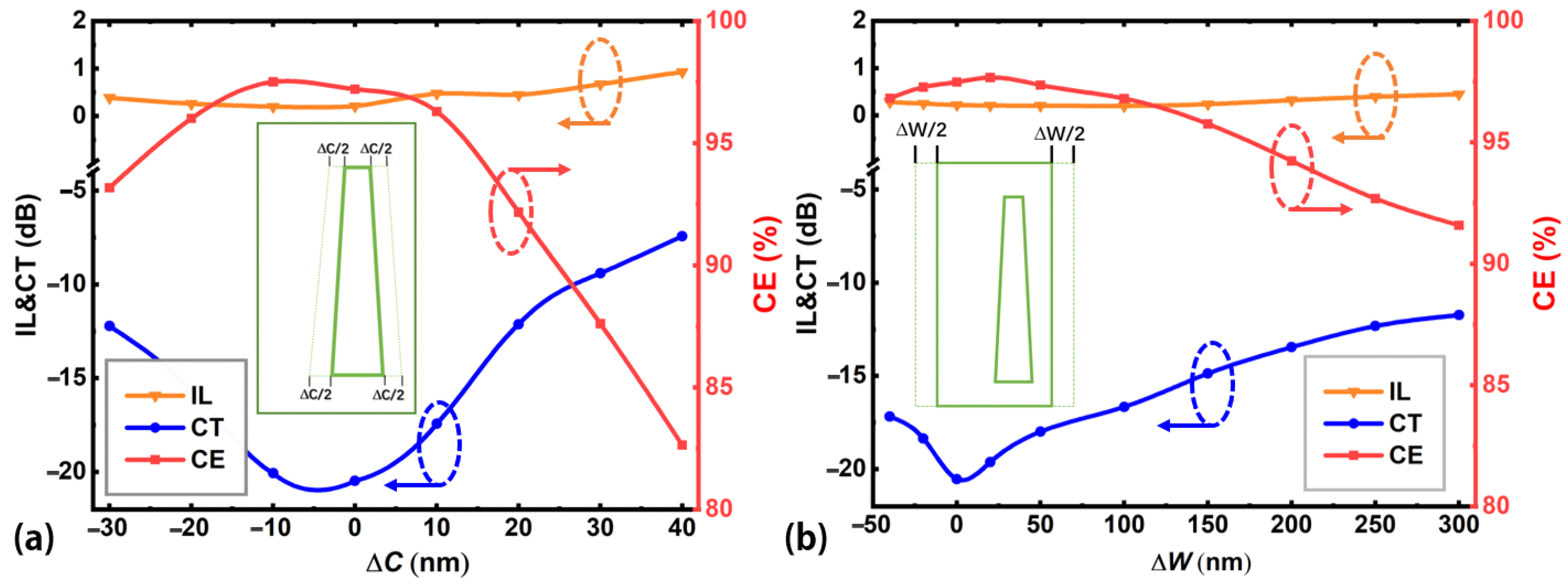




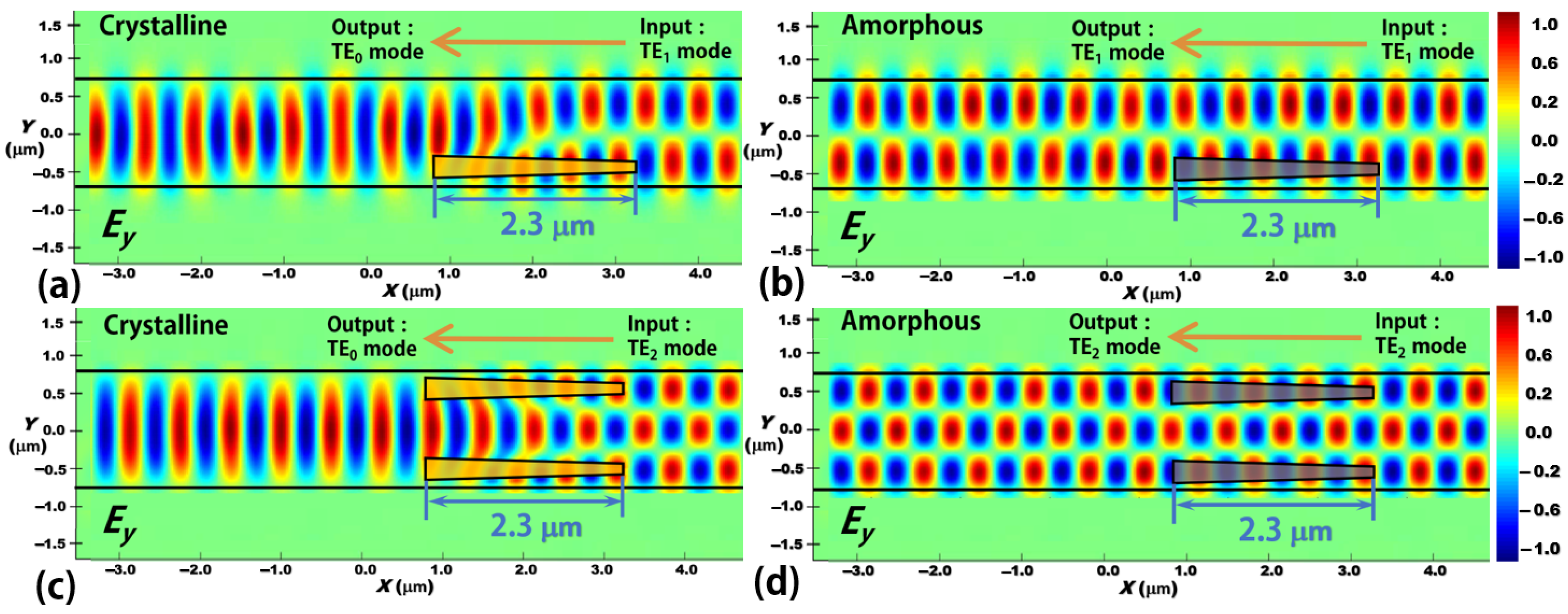
| Structure | Function | Length (μm) | CE (%) | CT (dB) | IL (dB) | BW (nm) | Reconfigurability |
|---|---|---|---|---|---|---|---|
| ADC [16] | TE0-to-TM0 [E] | 44 | >92 | <−15 | <1 | 40 (CE > 92%) | NO |
| DES [18] | TE0-to-TE1 [E] TE0-to-TE2 [E] | 2.3 2.4 | - - | ~−10 ~−14 | <0.5 <0.3 | 60 (CT < −7 dB) 50 (CT < −9 dB) | NO NO |
| SES [20] | TM0-to-TM2 [S] | 6 | ~94 | <−15 | ~0.5 | 128 (CE > 94%) | NO |
| TMS [24] | TE0-to-TM1 [S] | 11 | - | <−25 | 4.2 | 100 (CT < −20 dB) | NO |
| HPS [25] | TE0-to-TM1 [S] | 7 | 94.6 | - | <2.34 | 35 (CE > 92.2%) | NO |
| This work | TE0-to-TE1 [S] | 2.3 | 97.5 | <−20.5 | 0.2 | 210 (CE > 90%) | YES |
| TE0-to-TE2 [S] | 2.3 | 99.4 | <−25.2 | 0.11 | 245 (CE > 90%) | YES |
Publisher’s Note: MDPI stays neutral with regard to jurisdictional claims in published maps and institutional affiliations. |
© 2022 by the authors. Licensee MDPI, Basel, Switzerland. This article is an open access article distributed under the terms and conditions of the Creative Commons Attribution (CC BY) license (https://creativecommons.org/licenses/by/4.0/).
Share and Cite
Fei, Y.; Xu, Y.; Huang, D.; Dong, Y.; Zhang, B.; Ni, Y.; Wai, P.K.A. On-Chip Reconfigurable and Ultracompact Silicon Waveguide Mode Converters Based on Nonvolatile Optical Phase Change Materials. Nanomaterials 2022, 12, 4225. https://doi.org/10.3390/nano12234225
Fei Y, Xu Y, Huang D, Dong Y, Zhang B, Ni Y, Wai PKA. On-Chip Reconfigurable and Ultracompact Silicon Waveguide Mode Converters Based on Nonvolatile Optical Phase Change Materials. Nanomaterials. 2022; 12(23):4225. https://doi.org/10.3390/nano12234225
Chicago/Turabian StyleFei, Yedeng, Yin Xu, Dongmei Huang, Yue Dong, Bo Zhang, Yi Ni, and P. K. A. Wai. 2022. "On-Chip Reconfigurable and Ultracompact Silicon Waveguide Mode Converters Based on Nonvolatile Optical Phase Change Materials" Nanomaterials 12, no. 23: 4225. https://doi.org/10.3390/nano12234225






